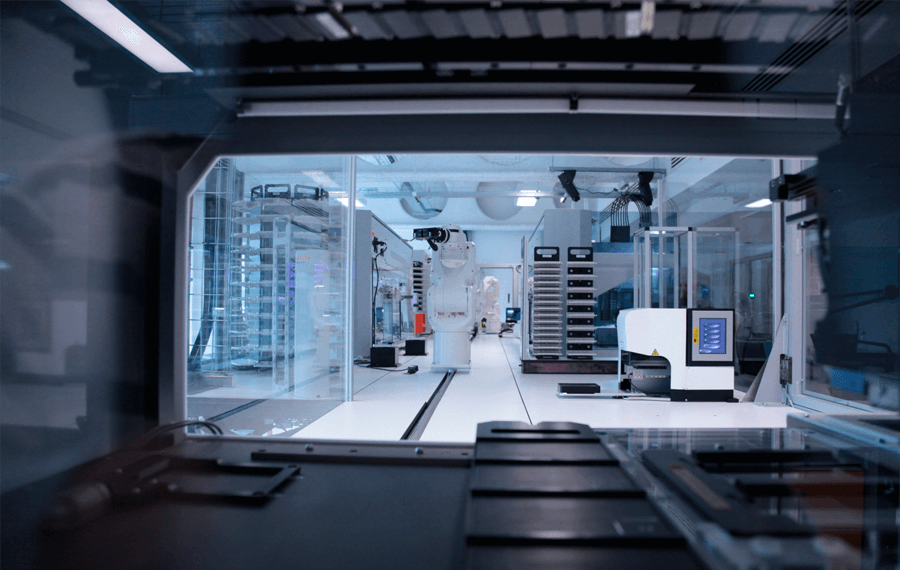エジンバラ大学
企業/大学
エジンバラ大学
チームメンバー
エジンバラ大学合成システム生物学センター エジンバラゲノムファウンドリー マネージャーヒレ・テコッテ博士
使用製品
QPix400 微生物コロニーピッカー
課題
エジンバラ・ゲノム・ファウンドリー(EGF)は、完全自動化されたロボット・プラットフォームを使用して、顧客のために遺伝物質を製造しています。これらのDNAコンストラクトは、個別化医療に使用するための幹細胞のプログラミング、病気検出バクテリアの製造、バイオ燃料作物の収量増加など、細胞や生物全体に新たな機能や改善された機能を持たせるために使用される。
正確なサンプルとデータ追跡でハイスループットを達成するために、EGFは、自動化対応のSBSフォーマットトレイに複数のサンプルをプレーティングし、ストリークすることもできる自動コロニーピッキングシステムを必要としていた。さらに、このシステムは既存の自動ワークフローに完全統合できるものでなければならなかった。そのためには、ワークフロー内の他のインストゥルメンテーションへのサンプルハンドリングと受け渡しのために、サードパーティのロボットアームへのアクセスを可能にするハードウェアとソフトウェアの修正が必要でした。

解決策
EGFのニーズを満たすため、Advanced Workflow Engineering Solutions(AWES)チームはQPix 420システムを改造し、リキッドハンドリング用のハードウェアを提供するとともに、ロボットアームにアクセスできるように構造設計を変更しました。このカスタマイズされた構成をQPix Select-HTシステムと名付けました。さらに、マイクロプレートの寸法に関するSBS規格に適合する、分割されていない1枚の寒天トレイに8検体を広げることができるカスタムQPixヘッドを開発した。また、独自に調整された各プロセスのためのオープンAPIとソフトウェアサポートも提供された。QPix Select-HTシステムは、3つのロボットアーム、2つの自動リキッドハンドラー、インキュベーター、PCR装置(標準とリアルタイムの両方)、アコースティックディスペンサー、遠心機、プレートシーラーとピーラー、デリッダー、キャッパー/デキャッパーを含む自動化プラットフォームにEGFによって完全統合型とされた。
・斬新なワークフローに対応するため、QPixハードウェアとソフトウェアをカスタマイズ
・カスタムピッキングヘッドの設計と製造
使用製品
-

QPix 微生物コロニーピッカー
微生物コロニーピッカーのQPix™ 400シリーズは、ピッキング前のスクリーニングステップで、コロニーの検出と蛍光マーカーの定量を同時に行うユニークなオプションを提供します。QPixシステムは、研究機関、シーケンシング施設、バイオテクノロジー企業、製薬企業など、世界中で600以上の施設で使用されています。QPixロボット研究は、ヒトゲノムプロジェクト期間中、シーケンシングセンターにおける信頼性と精度の高さで有名になりました。
単なるコロニーピッカーではなく、これらのシステムにより科学者は以下のことが可能になります:
・サンプリング、散布からピッキングまでの自動ワークフロー
・毎回正しいコロニーをピッキングする。
・タンパク質の発現、バイオ燃料研究、酵素の進化、ファージディスプレイ、DNAシーケンス、ライブラリーの生成と管理など、大規模で多様な集団を効率的に管理する
結果
QPix Select-HTシステムは、1時間で最大200サンプルのプレーティング、または最大3,000コロニーのピッキングが可能で、顧客へのタイムリーな製品供給に必要なハイスループット・サンプリングを実現します。各プロセスには信頼性の高いサンプル追跡とデータ管理もあり、EGFは自動ワークフロー全体のサンプルデータを効率的に管理できる。完全自動ワークフローにシステムを統合することで、システム稼動に必要な従業員の労働時間も削減されるため、EGFの各プロジェクトの財務コストも削減される。モレキュラーデバイスのAWESチームとEdinburgh Genome Foundry社との緊密なコラボレーションは、彼らの特異性ワークフローニーズに対する効果的なソリューションとなり、EGFはDNAアセンブリーの完全自動化プラットフォームという目標を達成することができました。
ケーススタディの全文をダウンロードする(PDF版)
エジンバラゲノムファウンドリーでQPixの実機を見る
参考文献:
Wevers, N.R. et al. マイクロ流路プラットフォームにおけるニューロンとグリアの3Dネットワーク上でのハイスループット化合物評価。Nature Scientific Reports 6、論文番号:38856(2016)。
Junaida A. et al. エンドユーザーの視点から見たOrgan-on-a-Chip: Assays and Usability Aspects. Current Opinion in Biomedical Engineering. Article in Press (2017).


